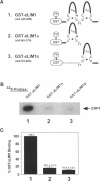Abstract
LIM domains are novel sequence elements that are found in more than 60 gene products, many of which function as key regulators of developmental pathways. The LIM domain, characterized by the cysteine-rich consensus CX2CX16-23HX2CX2CX2CX16-21 CX2-3(C/H/ D), is a specific mental-binding structure that consists of two distinct zinc-binding subdomains. We and others have recently demonstrated that the LIM domain mediates protein-protein interactions. However, the sequences that define the protein-binding specificity of the LIM domain had not yet been identified. Because structural studies have revealed that the C-terminal zinc-binding module of a LIM domain displays a tertiary fold compatible with nucleic acid binding, it was of interest to determine whether the specific protein-binding activity of a LIM domain could be ascribed to one of its two zinc-binding subdomains. To address this question, we have analyzed the protein-binding capacity of a model LIM peptide, called zLIM1, that is derived from the cytoskeletal protein zyxin. These studies demonstrate that the protein-binding function of zLIM1 can be mapped to sequences contained within its N-terminal zinc-binding module. The C-terminal zinc-binding module of zLIM1 may thus remain accessible to additional interactive partners. Our results raise the possibility that the two structural subdomains of a LIM domain are capable of performing distinct biochemical functions.
Full text
PDF
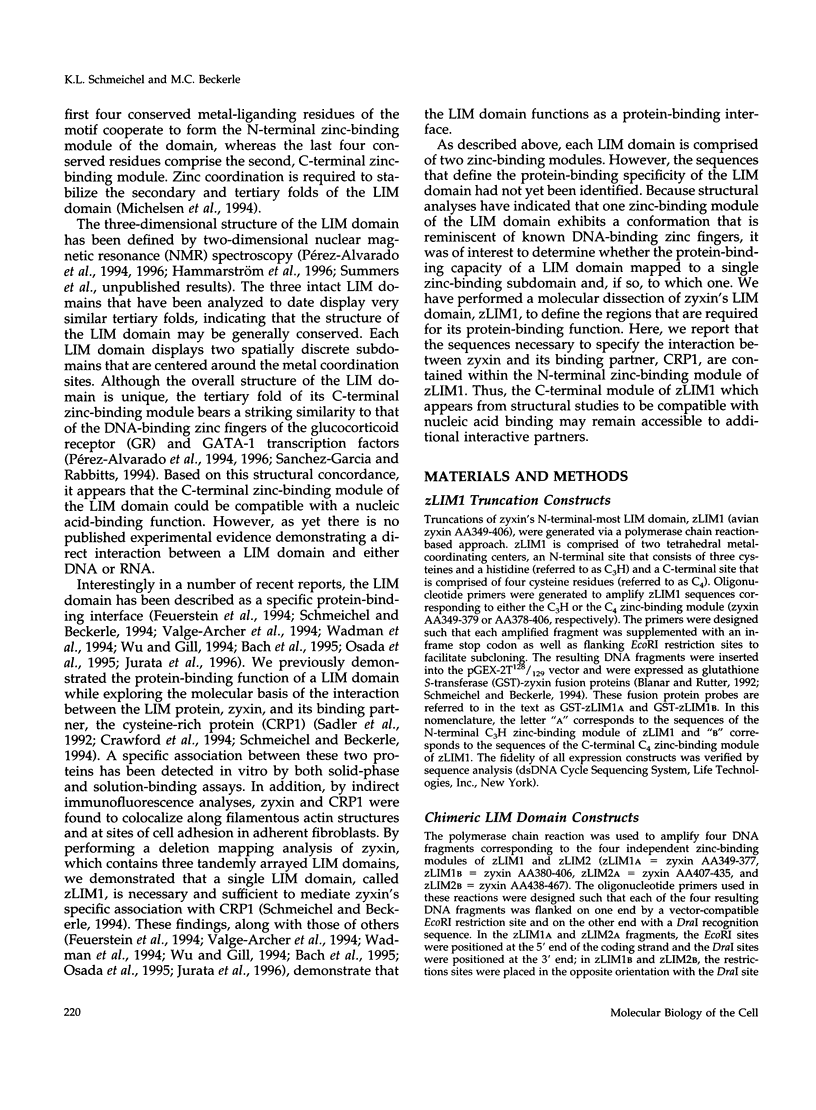

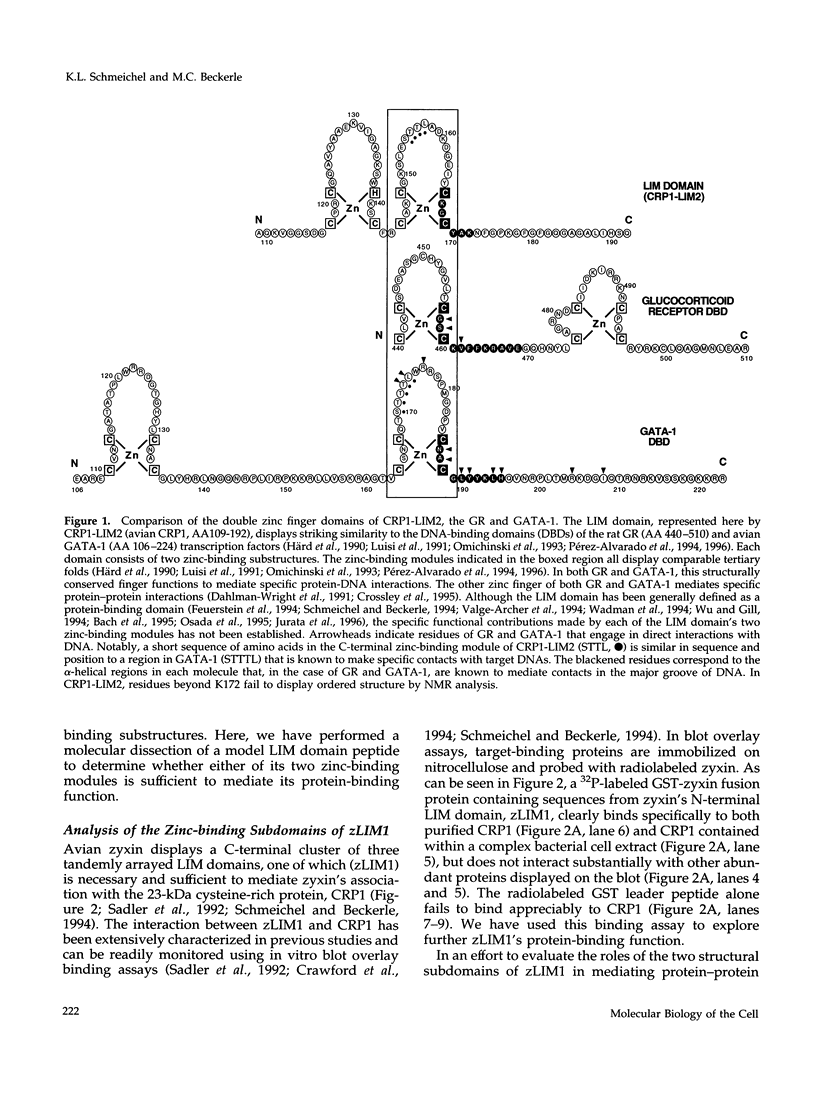

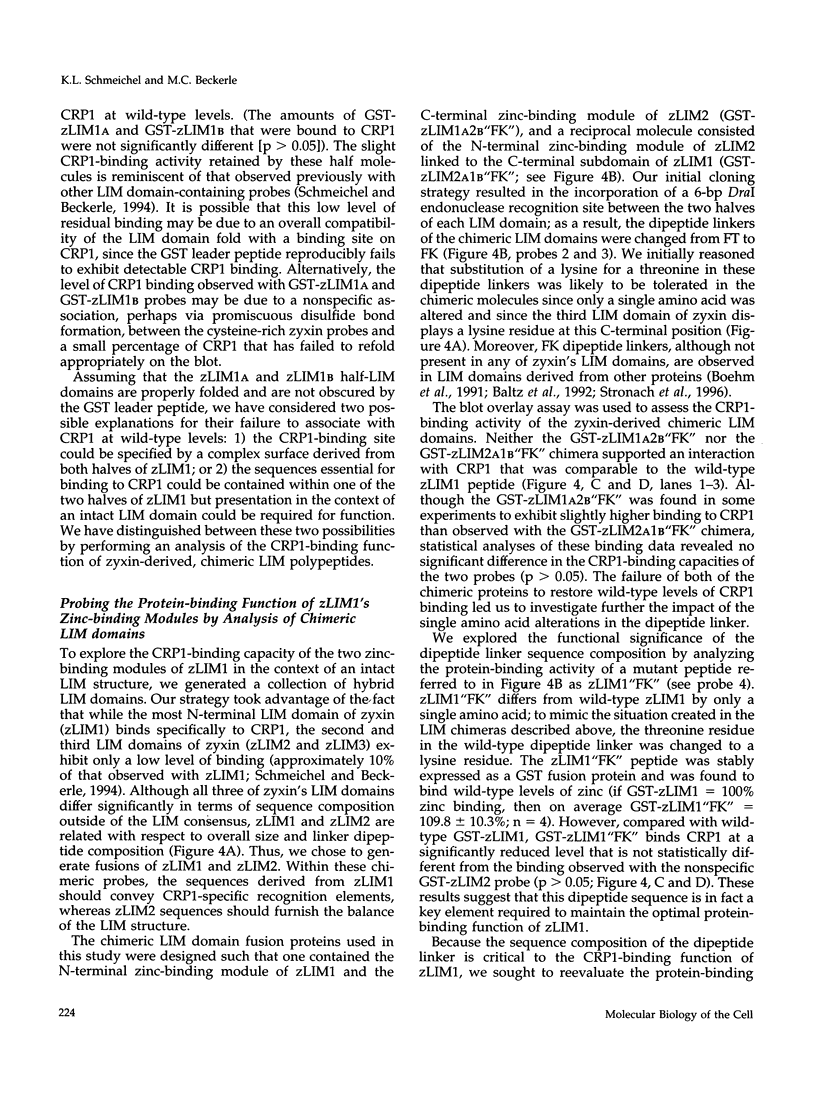
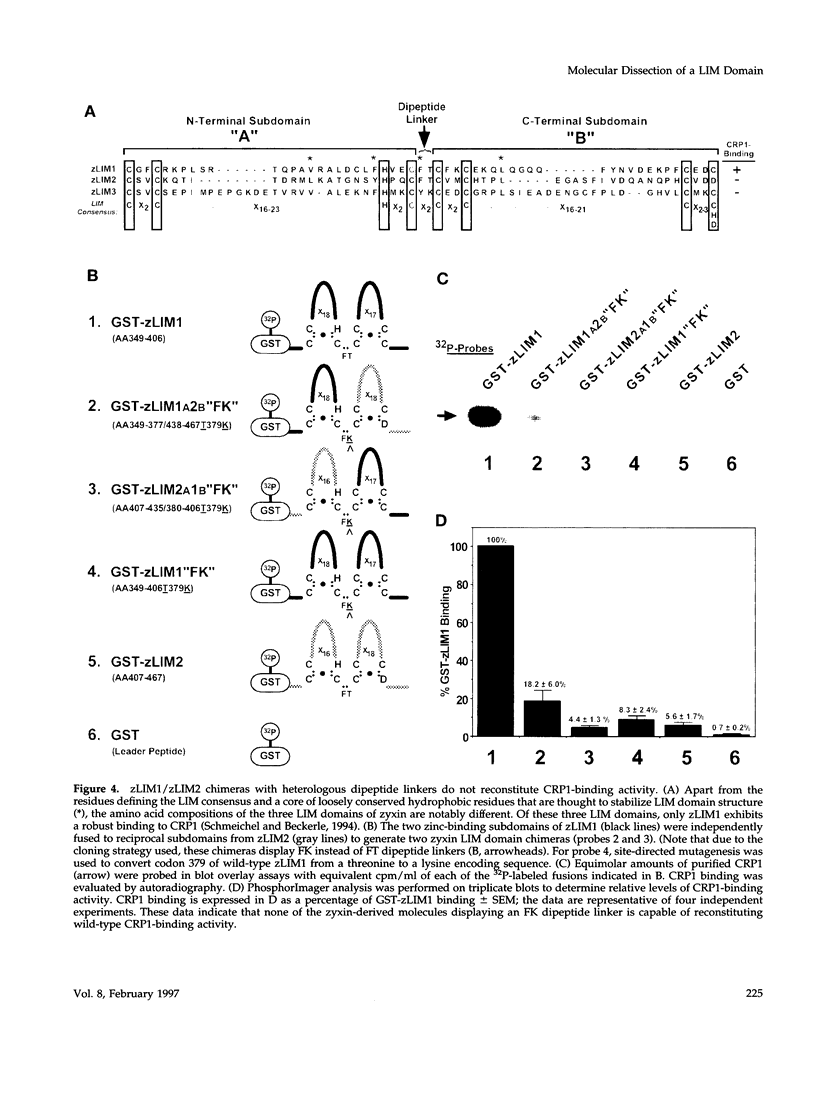


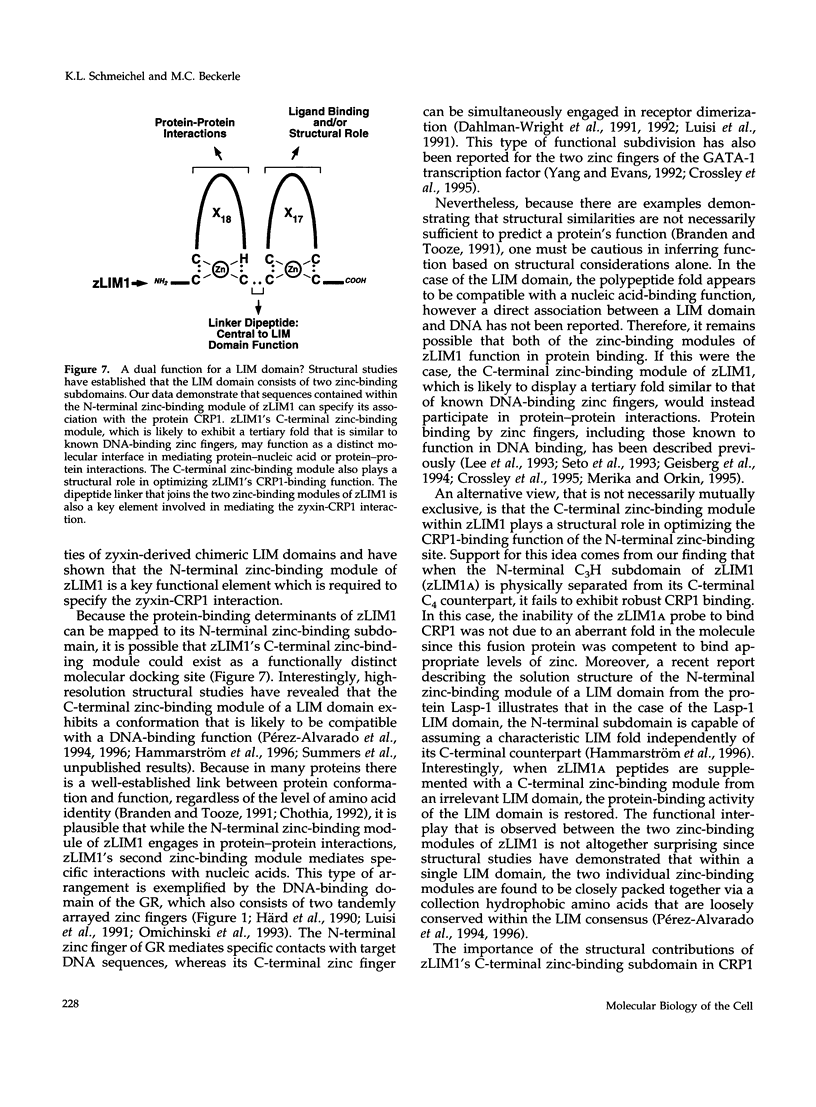

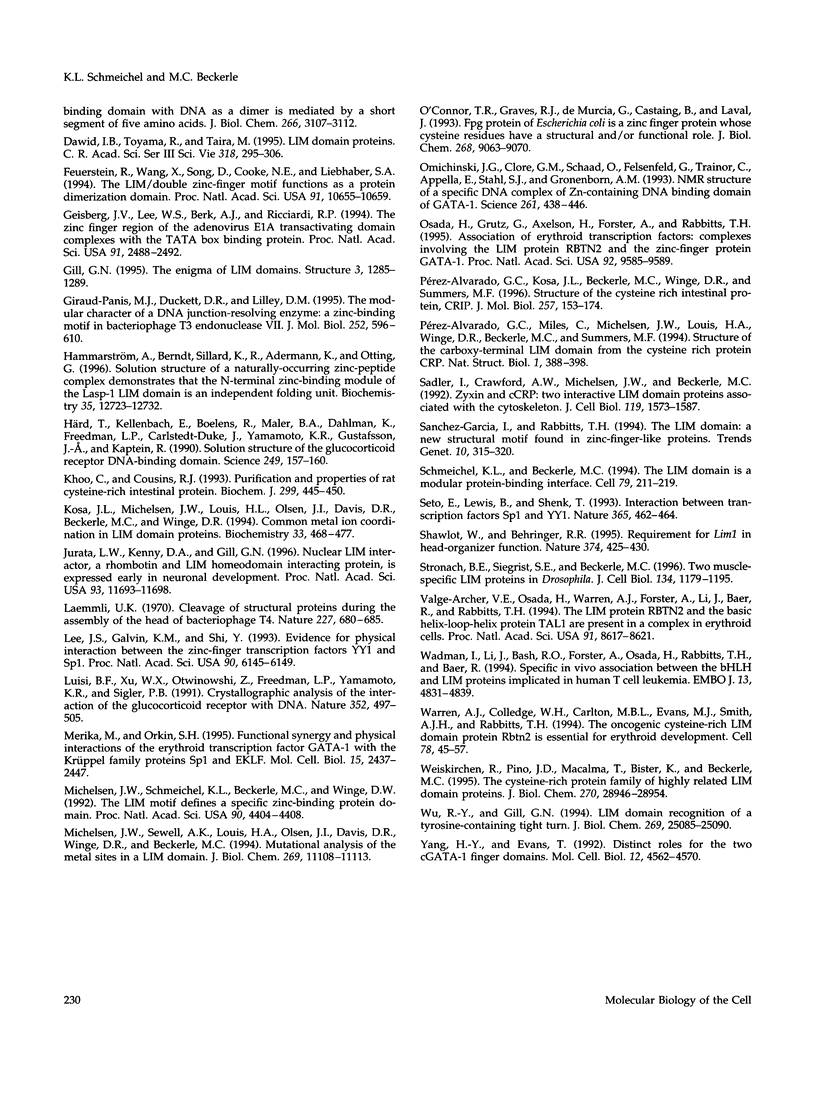
Images in this article
Selected References
These references are in PubMed. This may not be the complete list of references from this article.
- Archer V. E., Breton J., Sanchez-Garcia I., Osada H., Forster A., Thomson A. J., Rabbitts T. H. Cysteine-rich LIM domains of LIM-homeodomain and LIM-only proteins contain zinc but not iron. Proc Natl Acad Sci U S A. 1994 Jan 4;91(1):316–320. doi: 10.1073/pnas.91.1.316. [DOI] [PMC free article] [PubMed] [Google Scholar]
- Bach I., Rhodes S. J., Pearse R. V., 2nd, Heinzel T., Gloss B., Scully K. M., Sawchenko P. E., Rosenfeld M. G. P-Lim, a LIM homeodomain factor, is expressed during pituitary organ and cell commitment and synergizes with Pit-1. Proc Natl Acad Sci U S A. 1995 Mar 28;92(7):2720–2724. doi: 10.1073/pnas.92.7.2720. [DOI] [PMC free article] [PubMed] [Google Scholar]
- Baltz R., Domon C., Pillay D. T., Steinmetz A. Characterization of a pollen-specific cDNA from sunflower encoding a zinc finger protein. Plant J. 1992 Sep;2(5):713–721. [PubMed] [Google Scholar]
- Barnes J. D., Crosby J. L., Jones C. M., Wright C. V., Hogan B. L. Embryonic expression of Lim-1, the mouse homolog of Xenopus Xlim-1, suggests a role in lateral mesoderm differentiation and neurogenesis. Dev Biol. 1994 Jan;161(1):168–178. doi: 10.1006/dbio.1994.1018. [DOI] [PubMed] [Google Scholar]
- Blanar M. A., Rutter W. J. Interaction cloning: identification of a helix-loop-helix zipper protein that interacts with c-Fos. Science. 1992 May 15;256(5059):1014–1018. doi: 10.1126/science.1589769. [DOI] [PubMed] [Google Scholar]
- Boehm T., Foroni L., Kaneko Y., Perutz M. F., Rabbitts T. H. The rhombotin family of cysteine-rich LIM-domain oncogenes: distinct members are involved in T-cell translocations to human chromosomes 11p15 and 11p13. Proc Natl Acad Sci U S A. 1991 May 15;88(10):4367–4371. doi: 10.1073/pnas.88.10.4367. [DOI] [PMC free article] [PubMed] [Google Scholar]
- Chothia C. Proteins. One thousand families for the molecular biologist. Nature. 1992 Jun 18;357(6379):543–544. doi: 10.1038/357543a0. [DOI] [PubMed] [Google Scholar]
- Crawford A. W., Michelsen J. W., Beckerle M. C. An interaction between zyxin and alpha-actinin. J Cell Biol. 1992 Mar;116(6):1381–1393. doi: 10.1083/jcb.116.6.1381. [DOI] [PMC free article] [PubMed] [Google Scholar]
- Crawford A. W., Pino J. D., Beckerle M. C. Biochemical and molecular characterization of the chicken cysteine-rich protein, a developmentally regulated LIM-domain protein that is associated with the actin cytoskeleton. J Cell Biol. 1994 Jan;124(1-2):117–127. doi: 10.1083/jcb.124.1.117. [DOI] [PMC free article] [PubMed] [Google Scholar]
- Crossley M., Merika M., Orkin S. H. Self-association of the erythroid transcription factor GATA-1 mediated by its zinc finger domains. Mol Cell Biol. 1995 May;15(5):2448–2456. doi: 10.1128/mcb.15.5.2448. [DOI] [PMC free article] [PubMed] [Google Scholar]
- Dahlman-Wright K., Wright A., Carlstedt-Duke J., Gustafsson J. A. DNA-binding by the glucocorticoid receptor: a structural and functional analysis. J Steroid Biochem Mol Biol. 1992 Mar;41(3-8):249–272. doi: 10.1016/0960-0760(92)90351-i. [DOI] [PubMed] [Google Scholar]
- Dawid I. B., Toyama R., Taira M. LIM domain proteins. C R Acad Sci III. 1995 Mar;318(3):295–306. [PubMed] [Google Scholar]
- Feuerstein R., Wang X., Song D., Cooke N. E., Liebhaber S. A. The LIM/double zinc-finger motif functions as a protein dimerization domain. Proc Natl Acad Sci U S A. 1994 Oct 25;91(22):10655–10659. doi: 10.1073/pnas.91.22.10655. [DOI] [PMC free article] [PubMed] [Google Scholar]
- Geisberg J. V., Lee W. S., Berk A. J., Ricciardi R. P. The zinc finger region of the adenovirus E1A transactivating domain complexes with the TATA box binding protein. Proc Natl Acad Sci U S A. 1994 Mar 29;91(7):2488–2492. doi: 10.1073/pnas.91.7.2488. [DOI] [PMC free article] [PubMed] [Google Scholar]
- Gill G. N. The enigma of LIM domains. Structure. 1995 Dec 15;3(12):1285–1289. doi: 10.1016/s0969-2126(01)00265-9. [DOI] [PubMed] [Google Scholar]
- Giraud-Panis M. J., Duckett D. R., Lilley D. M. The modular character of a DNA junction-resolving enzyme: a zinc-binding motif in bacteriophage T4 endonuclease VII. J Mol Biol. 1995 Oct 6;252(5):596–610. doi: 10.1006/jmbi.1995.0523. [DOI] [PubMed] [Google Scholar]
- Hammarström A., Berndt K. D., Sillard R., Adermann K., Otting G. Solution structure of a naturally-occurring zinc-peptide complex demonstrates that the N-terminal zinc-binding module of the Lasp-1 LIM domain is an independent folding unit. Biochemistry. 1996 Oct 1;35(39):12723–12732. doi: 10.1021/bi961149j. [DOI] [PubMed] [Google Scholar]
- Härd T., Kellenbach E., Boelens R., Maler B. A., Dahlman K., Freedman L. P., Carlstedt-Duke J., Yamamoto K. R., Gustafsson J. A., Kaptein R. Solution structure of the glucocorticoid receptor DNA-binding domain. Science. 1990 Jul 13;249(4965):157–160. doi: 10.1126/science.2115209. [DOI] [PubMed] [Google Scholar]
- Jurata L. W., Kenny D. A., Gill G. N. Nuclear LIM interactor, a rhombotin and LIM homeodomain interacting protein, is expressed early in neuronal development. Proc Natl Acad Sci U S A. 1996 Oct 15;93(21):11693–11698. doi: 10.1073/pnas.93.21.11693. [DOI] [PMC free article] [PubMed] [Google Scholar]
- Khoo C., Cousins R. J. Purification and properties of rat cysteine-rich intestinal protein. Biochem J. 1994 Apr 15;299(Pt 2):445–450. doi: 10.1042/bj2990445. [DOI] [PMC free article] [PubMed] [Google Scholar]
- Kosa J. L., Michelsen J. W., Louis H. A., Olsen J. I., Davis D. R., Beckerle M. C., Winge D. R. Common metal ion coordination in LIM domain proteins. Biochemistry. 1994 Jan 18;33(2):468–477. doi: 10.1021/bi00168a011. [DOI] [PubMed] [Google Scholar]
- Laemmli U. K. Cleavage of structural proteins during the assembly of the head of bacteriophage T4. Nature. 1970 Aug 15;227(5259):680–685. doi: 10.1038/227680a0. [DOI] [PubMed] [Google Scholar]
- Lee J. S., Galvin K. M., Shi Y. Evidence for physical interaction between the zinc-finger transcription factors YY1 and Sp1. Proc Natl Acad Sci U S A. 1993 Jul 1;90(13):6145–6149. doi: 10.1073/pnas.90.13.6145. [DOI] [PMC free article] [PubMed] [Google Scholar]
- Luisi B. F., Xu W. X., Otwinowski Z., Freedman L. P., Yamamoto K. R., Sigler P. B. Crystallographic analysis of the interaction of the glucocorticoid receptor with DNA. Nature. 1991 Aug 8;352(6335):497–505. doi: 10.1038/352497a0. [DOI] [PubMed] [Google Scholar]
- Merika M., Orkin S. H. Functional synergy and physical interactions of the erythroid transcription factor GATA-1 with the Krüppel family proteins Sp1 and EKLF. Mol Cell Biol. 1995 May;15(5):2437–2447. doi: 10.1128/mcb.15.5.2437. [DOI] [PMC free article] [PubMed] [Google Scholar]
- Michelsen J. W., Schmeichel K. L., Beckerle M. C., Winge D. R. The LIM motif defines a specific zinc-binding protein domain. Proc Natl Acad Sci U S A. 1993 May 15;90(10):4404–4408. doi: 10.1073/pnas.90.10.4404. [DOI] [PMC free article] [PubMed] [Google Scholar]
- Michelsen J. W., Sewell A. K., Louis H. A., Olsen J. I., Davis D. R., Winge D. R., Beckerle M. C. Mutational analysis of the metal sites in an LIM domain. J Biol Chem. 1994 Apr 15;269(15):11108–11113. [PubMed] [Google Scholar]
- O'Connor T. R., Graves R. J., de Murcia G., Castaing B., Laval J. Fpg protein of Escherichia coli is a zinc finger protein whose cysteine residues have a structural and/or functional role. J Biol Chem. 1993 Apr 25;268(12):9063–9070. [PubMed] [Google Scholar]
- Omichinski J. G., Clore G. M., Schaad O., Felsenfeld G., Trainor C., Appella E., Stahl S. J., Gronenborn A. M. NMR structure of a specific DNA complex of Zn-containing DNA binding domain of GATA-1. Science. 1993 Jul 23;261(5120):438–446. doi: 10.1126/science.8332909. [DOI] [PubMed] [Google Scholar]
- Osada H., Grutz G., Axelson H., Forster A., Rabbitts T. H. Association of erythroid transcription factors: complexes involving the LIM protein RBTN2 and the zinc-finger protein GATA1. Proc Natl Acad Sci U S A. 1995 Oct 10;92(21):9585–9589. doi: 10.1073/pnas.92.21.9585. [DOI] [PMC free article] [PubMed] [Google Scholar]
- Pérez-Alvarado G. C., Kosa J. L., Louis H. A., Beckerle M. C., Winge D. R., Summers M. F. Structure of the cysteine-rich intestinal protein, CRIP. J Mol Biol. 1996 Mar 22;257(1):153–174. doi: 10.1006/jmbi.1996.0153. [DOI] [PubMed] [Google Scholar]
- Pérez-Alvarado G. C., Miles C., Michelsen J. W., Louis H. A., Winge D. R., Beckerle M. C., Summers M. F. Structure of the carboxy-terminal LIM domain from the cysteine rich protein CRP. Nat Struct Biol. 1994 Jun;1(6):388–398. doi: 10.1038/nsb0694-388. [DOI] [PubMed] [Google Scholar]
- Sadler I., Crawford A. W., Michelsen J. W., Beckerle M. C. Zyxin and cCRP: two interactive LIM domain proteins associated with the cytoskeleton. J Cell Biol. 1992 Dec;119(6):1573–1587. doi: 10.1083/jcb.119.6.1573. [DOI] [PMC free article] [PubMed] [Google Scholar]
- Schmeichel K. L., Beckerle M. C. The LIM domain is a modular protein-binding interface. Cell. 1994 Oct 21;79(2):211–219. doi: 10.1016/0092-8674(94)90191-0. [DOI] [PubMed] [Google Scholar]
- Seto E., Lewis B., Shenk T. Interaction between transcription factors Sp1 and YY1. Nature. 1993 Sep 30;365(6445):462–464. doi: 10.1038/365462a0. [DOI] [PubMed] [Google Scholar]
- Shawlot W., Behringer R. R. Requirement for Lim1 in head-organizer function. Nature. 1995 Mar 30;374(6521):425–430. doi: 10.1038/374425a0. [DOI] [PubMed] [Google Scholar]
- Stronach B. E., Siegrist S. E., Beckerle M. C. Two muscle-specific LIM proteins in Drosophila. J Cell Biol. 1996 Sep;134(5):1179–1195. doi: 10.1083/jcb.134.5.1179. [DOI] [PMC free article] [PubMed] [Google Scholar]
- Sánchez-García I., Rabbitts T. H. The LIM domain: a new structural motif found in zinc-finger-like proteins. Trends Genet. 1994 Sep;10(9):315–320. doi: 10.1016/0168-9525(94)90034-5. [DOI] [PubMed] [Google Scholar]
- Valge-Archer V. E., Osada H., Warren A. J., Forster A., Li J., Baer R., Rabbitts T. H. The LIM protein RBTN2 and the basic helix-loop-helix protein TAL1 are present in a complex in erythroid cells. Proc Natl Acad Sci U S A. 1994 Aug 30;91(18):8617–8621. doi: 10.1073/pnas.91.18.8617. [DOI] [PMC free article] [PubMed] [Google Scholar]
- Wadman I., Li J., Bash R. O., Forster A., Osada H., Rabbitts T. H., Baer R. Specific in vivo association between the bHLH and LIM proteins implicated in human T cell leukemia. EMBO J. 1994 Oct 17;13(20):4831–4839. doi: 10.1002/j.1460-2075.1994.tb06809.x. [DOI] [PMC free article] [PubMed] [Google Scholar]
- Warren A. J., Colledge W. H., Carlton M. B., Evans M. J., Smith A. J., Rabbitts T. H. The oncogenic cysteine-rich LIM domain protein rbtn2 is essential for erythroid development. Cell. 1994 Jul 15;78(1):45–57. doi: 10.1016/0092-8674(94)90571-1. [DOI] [PubMed] [Google Scholar]
- Weiskirchen R., Pino J. D., Macalma T., Bister K., Beckerle M. C. The cysteine-rich protein family of highly related LIM domain proteins. J Biol Chem. 1995 Dec 1;270(48):28946–28954. doi: 10.1074/jbc.270.48.28946. [DOI] [PubMed] [Google Scholar]
- Wu R. Y., Gill G. N. LIM domain recognition of a tyrosine-containing tight turn. J Biol Chem. 1994 Oct 7;269(40):25085–25090. [PubMed] [Google Scholar]
- Yang H. Y., Evans T. Distinct roles for the two cGATA-1 finger domains. Mol Cell Biol. 1992 Oct;12(10):4562–4570. doi: 10.1128/mcb.12.10.4562. [DOI] [PMC free article] [PubMed] [Google Scholar]



